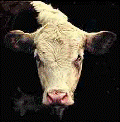Animal Science, Department of

Department of Animal Science: Dissertations, Theses, and Student Research
Date of this Version
8-2012
Document Type
Thesis
Abstract
Of the annual expenses necessary to maintain a beef cow, feed and forage are the greatest and most variable. Thus, nutrition programs for cow-calf operations must be developed using economical feedstuffs that optimize cowherd performance. The corn dry-milling industry provides several feedstuffs that are often the most economical sources of energy and protein, but considerations for storage and handling are necessary. Two experiments evaluated an alternative form of storing corn condensed distillers solubles (CCDS) by applying to grass hay windrows before baling. Round bales were treated with either 0 or 20% (Exp. 1); or 0, 16, and 32% (Exp. 2) CCDS (DM). Bale temperature was monitored and core samples collected. In either study, adding CCDS did not impact DM or the ability of hay to expel heat post-baling. Elevated CP and decreased NDF for CCDS-treated hay indicated within-bale storage occurred. Data suggest pre-baling application is feasible for storing liquid co-products while improving forage quality.
Two related experiments tested the feeding value of grass hay bales treated with CCDS in growing cattle diets. In Exp. 1, replacement heifers were offered ad libitum access to bales treated with 20% CCDS, or fed an equal dietary inclusion of dried distillers grains plus solubles (DDGS) and ad libitum hay. Heifers fed DDGS had increased ADG and BCS with more females cycling before breeding than heifers fed CCDS. Unequal co-product intake or metabolizable protein may have contributed to performance differences. To evaluate these effects, Exp. 2 was conducted as a completely randomized design with a 3 x 2 factorial arrangement of treatments. Factors included CCDS level (0, 15, or 30% of diet, DM) and supplementing to meet metabolizable protein requirements or not (MP or No MP). Steer DMI and performance improved with increasing dietary CCDS. Metabolizable protein improved gain but only for diets with 0% CCDS. Cattle performance data indicate within-bale storage of CCDS occurred, and windrow application before baling is a viable storage technique.
Adviser: Richard J. Rasby


Comments
A THESIS Presented to the Faculty of The Graduate College at the University of Nebraska In Partial Fulfillment of Requirements For the Degree of Master of Science, Major: Animal Science, Under the Supervision of Professor Richard J. Rasby. Lincoln, Nebraska: August, 2012
Copyright (c) 2012 Jason M. Warner